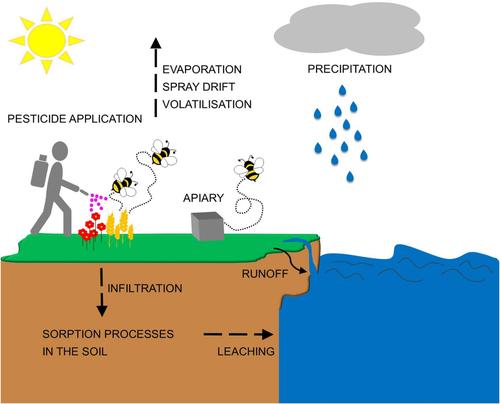当前位置:
X-MOL 学术
›
Pest Manag. Sci.
›
论文详情
Our official English website, www.x-mol.net, welcomes your
feedback! (Note: you will need to create a separate account there.)
Bee bread collected by honey bees (Apis mellifera) as a terrestrial pesticide biomarker to complement water studies
Pest Management Science ( IF 3.8 ) Pub Date : 2024-11-19 , DOI: 10.1002/ps.8541 Samira Stalder, Marion Fracheboud, Ann‐Kathrin Stalder, Benoît Droz, Aurea C. Chiaia‐Hernández, Christina Kast
Pest Management Science ( IF 3.8 ) Pub Date : 2024-11-19 , DOI: 10.1002/ps.8541 Samira Stalder, Marion Fracheboud, Ann‐Kathrin Stalder, Benoît Droz, Aurea C. Chiaia‐Hernández, Christina Kast

|
BACKGROUNDPesticides in aquatic environments are frequently studied, yet those in terrestrial environments remain relatively unexplored. This study monitored bee bread collected from two apiaries located in a typical agricultural environment in Switzerland from March to August 2022 as a proxy for terrestrial pesticide inputs. The temporal appearance of the selected pesticides was compared to their profiles in the water of a small catchment within this area.RESULTSOverall, 62% (31 of 50) of the targeted pesticides were detected in bee bread, with occurrences in both apiaries largely overlapping (23 pesticides), demonstrating a similar agricultural landscape across the region. Furthermore, nine pesticides were detected in bee bread and water, two pesticides were detected only in bee bread, and two additional pesticides were detected only in water. Comparative temporal analysis revealed that pesticides with moderate‐to‐high movement potential [Groundwater ubiquity score (GUS) ≥ 2.19] appeared simultaneously in bee bread and water (azoxystrobin, boscalid, flufenacet and terbuthylazine). However, pesticides with low movement potential (GUS ≤ 1.86) showed different profiles in both matrices (cyprodinil, prosulfocarb, tebuconazole and thiacloprid), indicating the difficulty of predicting their fate, given that they adhere to soil particles and cannot be covered by current water monitoring programmes.CONCLUSIONOur findings present bee bread as a viable biomarker for monitoring pesticides by complementing the conventional water monitoring, and permitting a more comprehensive assessment of the exposure of terrestrial organisms to pesticides. Bee bread allows immediate recording of the applied pesticides and promptly reflects the seasonal variation in pesticide use. © 2024 The Author(s). Pest Management Science published by John Wiley & Sons Ltd on behalf of Society of Chemical Industry.
中文翻译:

蜜蜂 (Apis mellifera) 收集的蜂面包作为陆生农药生物标志物,以补充水研究
背景水生环境中的杀虫剂经常被研究,但陆地环境中的杀虫剂仍然相对未被探索。本研究监测了 2022 年 3 月至 2022 年 8 月从位于瑞士典型农业环境中的两个养蜂场收集的蜂面包,作为陆地杀虫剂输入的代表。将所选农药的时间外观与它们在该地区一个小集水区的水中的情况进行了比较。结果总体而言,在蜂面包中检测到 62%(50 种中的 31 种)的目标杀虫剂,两个养蜂场的出现量基本重叠(23 种杀虫剂),表明整个地区的农业景观相似。此外,在蜂面包和水中检测到 9 种农药,仅在蜂面包中检测到 2 种农药,另外仅在水中检测到 2 种农药。比较时间分析显示,具有中度至高度移动潜力的农药 [地下水普遍性评分 (GUS) ≥ 2.19] 同时出现在蜂饼和水(嘧菌酯、啶酰菌胺、氟虫菌素和特布斯苯嗪)中。然而,低移动潜力的农药 (GUS ≤ 1.86) 在两种基质(环丙腈、原磺威、戊唑醇和噻虫啉)中显示出不同的特征,表明很难预测它们的命运,因为它们粘附在土壤颗粒上,并且无法被当前的水监测计划所覆盖。结论我们的研究结果表明,蜂面包通过补充传统的水监测来监测农药,并允许对陆地生物暴露于农药进行更全面的评估。蜂面包可以立即记录施用的农药,并及时反映农药使用的季节性变化。 © 2024 作者。由John Wiley & Sons Ltd代表化学工业协会出版的《害虫管理科学》。
更新日期:2024-11-19
中文翻译:

蜜蜂 (Apis mellifera) 收集的蜂面包作为陆生农药生物标志物,以补充水研究
背景水生环境中的杀虫剂经常被研究,但陆地环境中的杀虫剂仍然相对未被探索。本研究监测了 2022 年 3 月至 2022 年 8 月从位于瑞士典型农业环境中的两个养蜂场收集的蜂面包,作为陆地杀虫剂输入的代表。将所选农药的时间外观与它们在该地区一个小集水区的水中的情况进行了比较。结果总体而言,在蜂面包中检测到 62%(50 种中的 31 种)的目标杀虫剂,两个养蜂场的出现量基本重叠(23 种杀虫剂),表明整个地区的农业景观相似。此外,在蜂面包和水中检测到 9 种农药,仅在蜂面包中检测到 2 种农药,另外仅在水中检测到 2 种农药。比较时间分析显示,具有中度至高度移动潜力的农药 [地下水普遍性评分 (GUS) ≥ 2.19] 同时出现在蜂饼和水(嘧菌酯、啶酰菌胺、氟虫菌素和特布斯苯嗪)中。然而,低移动潜力的农药 (GUS ≤ 1.86) 在两种基质(环丙腈、原磺威、戊唑醇和噻虫啉)中显示出不同的特征,表明很难预测它们的命运,因为它们粘附在土壤颗粒上,并且无法被当前的水监测计划所覆盖。结论我们的研究结果表明,蜂面包通过补充传统的水监测来监测农药,并允许对陆地生物暴露于农药进行更全面的评估。蜂面包可以立即记录施用的农药,并及时反映农药使用的季节性变化。 © 2024 作者。由John Wiley & Sons Ltd代表化学工业协会出版的《害虫管理科学》。


















































 京公网安备 11010802027423号
京公网安备 11010802027423号